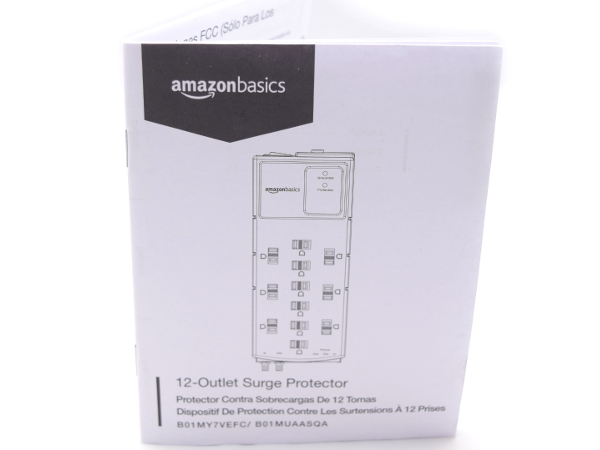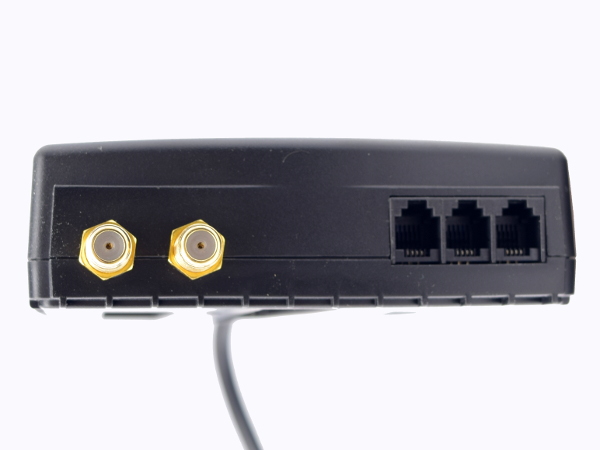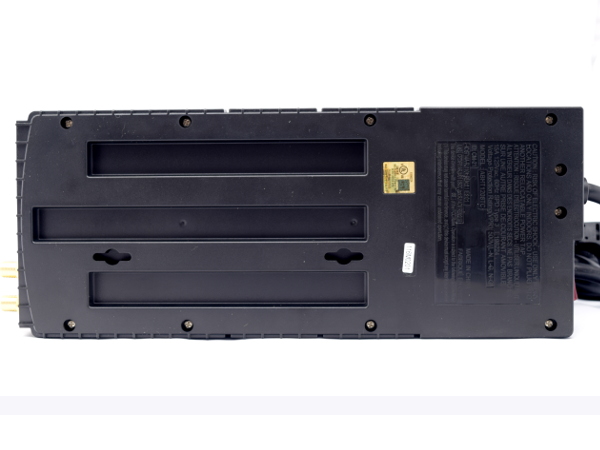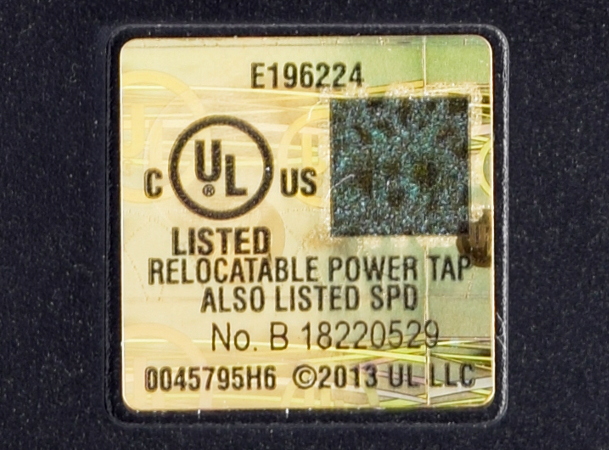AmazonBasics ABHT1208TC Surge Protector Tear-Down
The New Challenger
AmazonBasics may not be the first name an enthusiast thinks of when it comes to surge protection for PCs and related equipment. With the rise of online shopping, though, Amazon’s house brands are bound to garner increased exposure.
I recently went shopping for surge protection for my mother’s new flat-panel televisions, and Amazon’s ABHT1208TC came up along the usual suspects. More than a year had passed since my last surge protector tear-down, so I decided to buy one for $23 CAD (~$19 USD) and find out how it stacks up against established players like APC’s SurgeArrest Performance, which costs $10-15 more and serves up a seemingly comparable feature set.
MORE: APC BN650M1-CA UPS Tear-Down
MORE: CyberPower EC350G Tear-Down
MORE: APC BGE90M-CA Tear-Down
The Box
As is frequently the case for goods that ship directly from warehouses to consumers, the expense of colorful print on glossy paper laminated on cardboard gets skipped in favor of generic brown cardboard and a simple label to act as a seal identifying the contents.
According to the label, this surge protector has 4350 joules of surge suppression, which is 1330 more than APC's.
Get Tom's Hardware's best news and in-depth reviews, straight to your inbox.
MORE: APC BN650M1-CA UPS Tear-Down
MORE: CyberPower EC350G Tear-Down
MORE: APC BGE90M-CA Tear-Down
Accessories
The only other item inside, other than the power bar, is its multilingual manual, which rehashes the specifications and warnings on the box’s label. APC’s competitor comes with Velcro straps for cable management, a coax cable, and a phone cord, so there's roughly $5 worth of the price difference.
MORE: APC BN650M1-CA UPS Tear-Down
MORE: CyberPower EC350G Tear-Down
MORE: APC BGE90M-CA Tear-Down
Unboxed
Inside the box, the unit is wrapped inside a plastic bag. Usually when manufacturers do this, they also throw in a packet of silica gel and try to seal the bag to prevent metal parts from oxidizing while they sit in warehouses. Here though, it looks like the open bag’s only function is to protect the surface finish from scratches and friction during shipping.
MORE: APC BN650M1-CA UPS Tear-Down
MORE: CyberPower EC350G Tear-Down
MORE: APC BGE90M-CA Tear-Down
Shipping Cap
I believe this is the first surge protector I have looked at that ships with a protection boot on its RF connectors to protect them from getting knocked around. Then again, most other surge protectors are either tucked into custom-molded packaging or snug-fitting cardboard forms where the unit isn’t free to bounce around inside, as is the case with Amazon’s generic brown box.
MORE: APC BN650M1-CA UPS Tear-Down
MORE: CyberPower EC350G Tear-Down
MORE: APC BGE90M-CA Tear-Down
Plug
Here's another new plug style to add to the collection. This one is in somewhat of a P-shape, with a modest ridge along the top and back to help with grip. Assuming you grab this plug with your thumb in the nook and your fingers mainly on the back part near the neutral pin, maintaining a safe distance from the live pin shouldn’t be an issue. If you cannot access the outlet from an ideal angle, though, the irregular shape can be awkward.
MORE: APC BN650M1-CA UPS Tear-Down
MORE: CyberPower EC350G Tear-Down
MORE: APC BGE90M-CA Tear-Down
Cord
A fair number of sub-$40 surge protectors have 3×1.5mm² (#16) power cords. Surprisingly, that isn’t the case here. We instead get a whole 2.4 meters (eight feet) of 3×2.08mm² (#14) cord.
MORE: APC BN650M1-CA UPS Tear-Down
MORE: CyberPower EC350G Tear-Down
MORE: APC BGE90M-CA Tear-Down
Ports End
Two coax F-connectors and three telephone jacks sit directly on the seam between the two housing pieces instead of being inserted through housing holes with some alternate internal retention means. This simplifies the molds and assembly.
As far as I can remember, the other surge suppressors with coax ports I've seen had washers between their external nut and plastic housing. That's not the case here, so tack on another $0.05!
MORE: APC BN650M1-CA UPS Tear-Down
MORE: CyberPower EC350G Tear-Down
MORE: APC BGE90M-CA Tear-Down
Tail End
The side with the cable entry point features a typical rocker switch. We can't help but to be disappointed by the lack of strain relief at the cable’s entry point, which could lead to premature failure. Then again, most people rarely move their surge protectors, so failure from metal fatigue within the product's lifespan is pretty unlikely. There goes another $0.10!
MORE: APC BN650M1-CA UPS Tear-Down
MORE: CyberPower EC350G Tear-Down
MORE: APC BGE90M-CA Tear-Down
Back
The rear cover features a generous total of 10 screws holding Amazon’s surge protector together, two of which provide the clamping force near the cable's entry point to ensure it cannot be ripped out using force (within reason). Two wall-mounting slots provide means to mount the surge protector vertically in either orientation.
MORE: APC BN650M1-CA UPS Tear-Down
MORE: CyberPower EC350G Tear-Down
MORE: APC BGE90M-CA Tear-Down
Identity Check
Looking up UL listing E196224 reveals that Amazon’s ABHT1208TC is manufactured by CyberPower. With the amount of re-branding going on in every branch of the IT world, this shouldn’t be surprising at all. What do we expect to find inside? Likely a souped-up version of CyberPower’s unit in my $15 surge protector round-up from a few years ago.
MORE: APC BN650M1-CA UPS Tear-Down
MORE: CyberPower EC350G Tear-Down
MORE: APC BGE90M-CA Tear-Down
-
Zaporro "I’m guessing here, as none of them face outward for me to read numbers from, and I did not want to rip the tape off."Reply
Is this a joke? Most imporant part skipped because .... yea why? Its taken apart, there is no warranty anymore, it takes 1 second to rip tape with a knife and be thorough in a review.
Also, this and 99% of so called "surge protectors" look about the same and work the same, they are at most overglorified power splitters with on-off switch and indicator. Sure they might "protect" hardware from tiny spikes caused by say toilet ventilation fan but thats it. Any serious surge of installation fault will go through it like hot knife in butter. As far as RF/noise protection goes, most of mid/high range PSUs have it built in.
If someone really cares for their hardware and want real protection (instead of something to just to take it off your mind with illusion of safety) you go at minimum for AVR type UPS or perfectly full On-Line UPS type. -
Daniel Sauvageau Reply
Depending on where you live, "warranty void if opened" may have no legal standing. Where I live, if you can demonstrate with reasonable certainty that whatever you did has nothing to do with the original reason something needed to be open for repair, the manufacturer still has to fix the original fault even if you killed something else in the process of attempting to fix the original problem.20621770 said:Is this a joke? Most imporant part skipped because .... yea why? Its taken apart, there is no warranty anymore, it takes 1 second to rip tape with a knife and be thorough in a review.
As for why I didn't bother ripping the tape, that's simply because 20D201 or 20D271 doesn't really make that much of a difference: in case of a major surge, the full protection won't be reached until the 20D471s kick in and 270V is still within the normal input range of universal switching supplies which have to handle ~400V peak input. Also, that tape is there to keep the MOVs' heat trapped with their respective thermal fuses in case one of the MOVs overheats. Since I bought this power bar to give to my mother, I didn't want to mess with the original tape which is part of the device's safety mechanisms. If you dig out my past tear-downs, you will see that I've never bothered to remove shrink/tape from MOVs if I couldn't easily put it back on either - unless I had no plan to use the device post tear-down.
If you think a UPS will protect anything from surges, you are sorely mistaken: power line surges are microsecond-scale events while standby UPS have a switching time measured in milliseconds. Standby UPS use relays to switch input/output power and those have millisecond-scale response time. Typical surges will be over and done with before the relay's contacts leave their original position even if the UPS itself had instantaneous event detection. The only UPS that can protect against that are dual-conversion "online" UPS which are converting AC to battery voltage back to AC again 100% of the time, cost $600+ and will add 5-10% to your power costs due to conversion losses. Also, if you look at my UPS tear-downs, the amount of surge protection they provide is more basic than what's in the ABHT here.
Also, although PSUs may have some degree of internal surge protection, most people would much prefer blowing up a $20-50 power bar which can be readily replaced by anyone and protect multiple devices at once than blowing up the protection (if any) within the PSUs inside their PC, monitors, TVs, proprietary power adapters and other peripherals which are far more difficult if not impossible to replace and more expensive. -
BlueCat57 Like the low profile plug but they always seem to be facing the wrong way for me or the cord isn't long enough once I plug it in.Reply
How many people actually run their coax through their surge protector? How many run their phone and/or ethernet through it?
You also now need a couple of USB ports on a surge protector now.
I'm still looking for the "perfect" surge protector. I wish I could design one and make a million dollars BEFORE the design got ripped off.
I'd like to see UPS systems designed horizontally like a surge protector. That would make them more versatile. With USB outlets and a BIG battery they would offer true backup power in a blackout. -
Daniel Sauvageau Reply
Especially in places where the construction code requires that outlets be installed upside-down so they don't look like smiley faces, then low-profile plugs end up sending their cord up.20638075 said:Like the low profile plug but they always seem to be facing the wrong way for me or the cord isn't long enough once I plug it in.
As for your little poll, back when I had cable internet, I did pass coax through my power bar. I've been on DSL for most of the past 10 years and I'm passing the phone line through the power bar, to the DSL modem, then Ethernet back to the power bar before going to my broadband router. That way, a phone line surge would need to overcome two layers of surge protection on top of the modem's own internal insulation before putting any of my LAN equipment at risk.
I'm not convinced about needing USB ports on power bars but I do have a few products sort-of in that category down the pipeline. Personally, most of my power bars are not particularly accessible. I prefer using USB charging stations and self-powered USB hubs which have much smaller desktop footprints for convenient access to 5V power.










